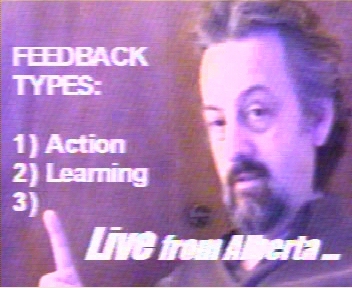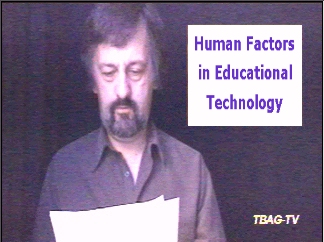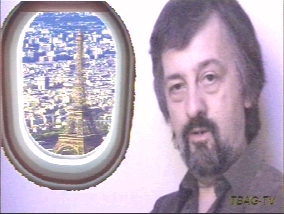  Prof. Jon Baggaley Athabasca University |
Live... From my Basement Studio! J.P. Baggaley |
|||||||||||||
|
Abstract The article describes a
cost-effective approach to online
video-conferencing in distance education (DE).
Many DE students are in remote parts of the
world, with slow dial-up connections, and cannot
participate in conferences requiring high-end
computer facilities. Participants may also
encounter obstructions to audio and video
transmission from institutional security
firewalls. A solution that takes account of all
of these problems is required. The writer
describes his home studio set-up, based on the
firewall-configurable freeware Yahoo
Messenger and a bank of old 486 PCs! He
describes how a home hobbyists' thrifty approach
can provide the same service and flexibility for
DE teachers and students as costly proprietary
conferencing tools. Introduction Distance education can be a
dry, impersonal affair. E-mail, the ‘phone,
and online text chats don’t exactly add the
human touch; and telephony-based
video-conferencing is beyond the means of most.
I have used internet audio to talk to my
students since 1999, but still craved a more
immediate sense of contact with them. Then
recently I watched King of Comedy, in
which Rupert Pupkin (alias Robert de Niro)
builds a TV set in his bedroom to practise being
a talk-show host. Fuelled by his vision, I have
built a similar set in my basement for the
weekly seminars I conduct with my online
students. I zoom, pan, superimpose titles, cut
to video, and step in and out of
PowerPoint presentations, all for their
enlightenment, and at no cost. Our weekly sessions are a
part of the Masters in Distance Education
studies at Athabasca University, in Alberta. The
MDE programme has been one of the first in N.
American distance education to move beyond the
DE media of ‘phone and online
correspondence, into a fully interactive
multimedia mode. To be sure, affluent campuses
around the world have used ISDN
video-conferencing for years; and in 1998 I
watched high-school teachers in Tokyo
broadcasting by satellite to 300,000 students
for seven hours a day. European readers of the
DIVERSE Newsletter will see nothing
unusual in this. But the UK and Japan are each
in a single time-zone, whereas Canada and the US
are spread across a 4.5-hour time lag, which
complicates the coordination of live sessions
for mature students with working
commitments. Unfortunately, the production
values typical of today’s educational
video-conferencing are as bleak as those of TV
in the 1950s, and a minute spent staring at my
fuzzy webcam image is likely to turn students
off the idea altogether. From a collection of
old hobbyist gadgets purchased as long as
fifteen years ago, however,
TeleBaggaley-TV has begun its
broadcasting day (TBAG), in a home basement TV
studio of which Rupert Pupkin would be
proud. I have replaced the webcam
with a 15-year old home-video camera. Text and
graphics are provided by three old 486 PCs with
Windows 3.1 and cheap TV output cards, through a
video mixer that cost 20 dollars twelve years
ago. One of the PCs contains a genlock overlay
card purchased in 1989, which combines the video
sources (Figures 1-4). The effects
produced allow me to pretend that the Rockies
are at the foot of my garden, and that I travel
frequently but make sure that I keep in touch
with my students at all cost (Figure
5-7).
TBAG-TV hits the road The inspiration for my
basement studio came in part from a 2002 visit
to DIVERSE member Dr. Claus Knudsen and his
colleagues at the Royal Institute of technology,
Stockholm. Claus interacts with his students
seamlessly via video links from his offices in
Sweden and Norway. Entering his office and
seeing him sitting at his desk, they can be
forgiven for wondering whether he is physically
present or a video projection. Dr. Knudsen
teachers his students an imaginative, even
surreal range of video production techniques for
increasing 'tele-presence' at a distance; and
his doctoral thesis (2004) is a remarkable
account of the cost-effective possibilities that
can accrue from academic need and practical
ingenuity. As Knudsen's work
demonstrates, such tele-presence experiments
truly bring about the "death of distance".
Teachers and students can interact with each
other regardless of their location, and, if they
have good laptop facilities, while travelling
around the world. In the previous DIVERSE
Newsletter (Baggaley, 2004b), I described the
practical lessons gained from a 'mobile
teaching' itinerary around Asia. In that
context, my basement studio in Alberta was
replaced by the internet kiosks of sophisticated
computing centres such as Thailand and
Indonesia, and of remote parts of Mongolia and
Bhutan. TBAG-TV tested this
possibility in early 2003, in producing our
first 'remote'! Packing the essential studio
gadgetry into my 'm-teaching' laptop case, I
travelled to Laos to organize a six-hour online
TV ‘talk-show’, linking delegates at
the PanAsia Networking Conference with my
students across Canada, and with experts in
India, the USA, and Sweden. We used Yahoo
Messenger, for the good technical reasons
outlined above, and because it allows up to 40
simultaneous participants to listen, talk, see,
and/or be seen, depending on their equipment.
Users who can afford more expensive tools
sometimes deride such freeware, though do not
necessarily enjoy better audio and video quality
from software costing in the five-figure range.
High-quality freeware gives the online educator
and student flexibility, compatibility, and
convergence; and the imaginative use of old
hardware prevents us from imposing expensive
requirements on our students - thereby
committing the educational technologist’s
cardinal sin of polarising society into
educational ‘haves’ and
‘have-nots’. Several massive efforts at
convergence by the computing and cable
industries have collapsed in recent years. Since
these industries are based on principles of
incompatibility and obsolescence, perhaps
neither we nor they should be too surprised by
this. As long as we can pick up the detritus of
their efforts - old pieces of hardware and
freeware for using them - interactive
convergence may yet be possible on a massive
scale. It is already being achieved on an
experimental level in Indian education. Some
time in the near future, when we are all panning
and zooming into one another’s homes from
our basement studios, we will look back and say,
“There was a time when I could just go
downstairs for a quiet read.” [This paper is a modified version of a presentation to the 4th Annual Conference of DIVERSE, held at InHolland University, Diemen, the Netherlands in July 2004. Thanks to Frances and Brady Young for letting me play in their basement! JPB]
References Baggaley, J.P. (2003). The Mellow Fruitfulness of Old Hardware. Workshop at the Pan-Asia Networking Conference, Vientiane, Laos, March. Baggaley, J. P. (2004a). Video-conferencing from the Basement and the Suitcase. 4th Annual Conference of DIVERSE, held at InHolland University, Diemen, the Netherlands, July. Baggaley, J. P. (2004b). M-learning how to M-teach. DIVERSE Newsletter 1, November. Knudsen, C. (2004). Presence Production. Doctor of Technology thesis. Royal Institute of technololgy Stockholm, October
|
||||||||||||||
|
|






